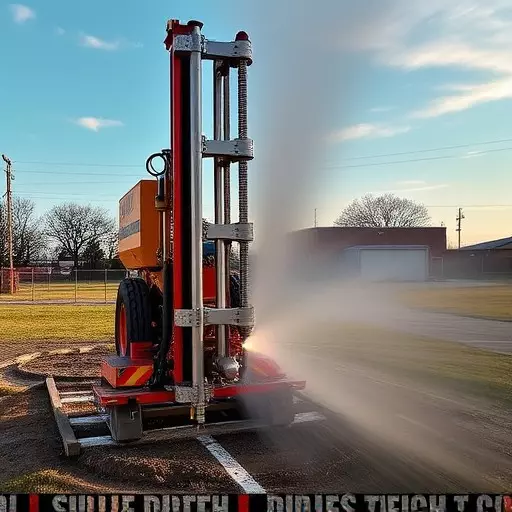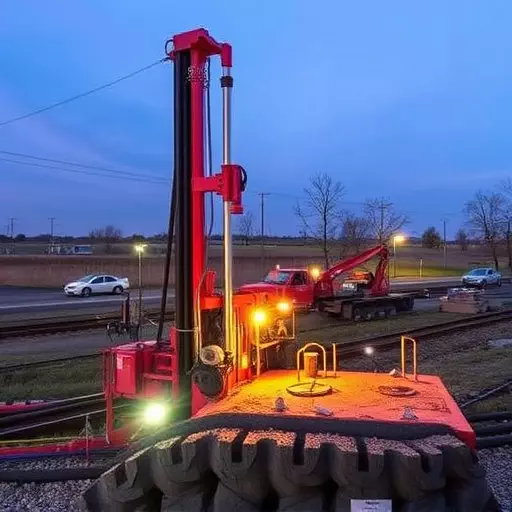Trenchless technology, including Directional Boring Toledo and Horizontal Directional Drilling (HDD), offers innovative solutions for installing, maintaining, or repairing underground utilities without traditional excavation. These methods minimize surface disruption, reduce environmental impact, lower costs, and enhance worker safety compared to open-cut methods. Trenchless Technology is particularly beneficial in urban areas where traditional methods cause significant damage, making it a disruptive game-changer in the utility sector with applications in telecommunications, water management, energy distribution, and construction industries. Directional Boring Toledo and HDD enable efficient, faster, and safer underground construction, transforming urban construction in Toledo while preserving existing infrastructure.
“Trenchless Technology: Revolutionizing Construction and Infrastructure Management
In an era where efficiency and safety are paramount, Trenchless Technology emerges as a game-changer. This innovative approach eliminates the need for traditional excavation methods, reducing risks and disruptions. From its roots in Horizontal Directional Drilling (HDD) to advanced directional boring techniques like the Toledo method, this technology is transforming industries.
Explore the diverse benefits, real-world applications, and future trends, as we delve into the world of Trenchless Technology, with a particular focus on the precision and efficiency of Directional Boring Toledo.”
- What is Trenchless Technology?
- Types of Trenchless Methods: A Comprehensive Overview
- Benefits and Advantages in Various Industries
- Directional Boring Toledo: Unlocking Underground Infrastructure
- Real-World Applications: Success Stories
- The Future of Excavation: Trends and Innovations
What is Trenchless Technology?

Trenchless technology refers to innovative methods and equipment used to install, maintain, or repair underground utilities without traditional excavation. This includes techniques like directional boring and horizontal directional drilling (HDD). Directional boring in Toledo, for instance, allows for precise, controlled movement of a drill bit along a predetermined path beneath the surface, creating a minimal footprint compared to open-cut methods.
Horizontal directional drilling is particularly effective for installing or replacing pipes, cables, or other utilities in tight spaces or areas where traditional excavation is impractical or disruptive. By utilizing these trenchless technologies, construction projects can be completed faster, with less environmental impact, reduced risk of damage to existing infrastructure above and below ground, and often at a lower cost compared to traditional open-cut methods.
Types of Trenchless Methods: A Comprehensive Overview

Trenchless technology encompasses a range of methods that enable the installation, maintenance, and repair of underground utilities without traditional excavation. These innovative approaches have revolutionized the construction industry by offering faster, more efficient, and environmentally friendly alternatives. Among the various trenchless methods, two prominent techniques stand out: Directional Boring and Horizontal Directional Drilling (HDD).
Directional Boring involves using a specialized machine to create a continuous tunnel or borehole beneath the surface, often in a curved path. This method is particularly useful for installing pipes, cables, or conduits where traditional excavation is challenging or disruptive. Horizontal Directional Drilling, on the other hand, employs a similar technique but with a focus on horizontal drilling, making it ideal for crossing long distances under roads, rivers, or other obstacles. Both methods offer significant advantages, including reduced disruption to surfaces above, minimal site disturbance, and increased safety for workers and surrounding infrastructure, thereby positioning trenchless technology as a game-changer in the utility installation and maintenance sector.
Benefits and Advantages in Various Industries

Trenchless technology, facilitated by methods like Horizontal Directional Drilling (HDD) and Directional Boring Toledo, offers a plethora of benefits across various industries. One of its most significant advantages is minimizing disruption to existing infrastructure, making it ideal for urban settings where digging traditional trenches can cause extensive damage and hinder daily activities. This non-invasive approach allows for the installation or repair of utilities beneath the ground without the need for large excavation equipment, thereby reducing noise pollution, traffic disruptions, and the potential for site contamination.
Moreover, trenchless technology enhances efficiency and reduces project timelines. HDD, for instance, can install or replace pipes, cables, and other utilities with precision, minimizing waste and maximizing material utilization. This method also lowers the risk of damage to buried structures and services, ensuring safer and more cost-effective operations. Its versatility is evident in industries such as telecommunications, water management, energy distribution, and construction, where it plays a pivotal role in modernizing infrastructure while minimizing environmental impact.
Directional Boring Toledo: Unlocking Underground Infrastructure

Directional Boring Toledo is a game-changer in the realm of trenchless technology, offering a vibrant and efficient solution for accessing underground infrastructure. This innovative method employs Horizontal Directional Drilling (HDD) to create precise tunnels beneath the earth’s surface, eliminating the need for traditional excavation methods. By navigating through the underground landscape with remarkable accuracy, HDD allows for the installation of utilities such as pipelines, cables, and fiber optics without disrupting the surface or disturbing nearby structures.
This technology has revolutionized the way we manage and maintain our underground networks. With Directional Boring Toledo, construction projects can be completed faster and more cost-effectively while minimizing environmental impact. The method’s versatility enables it to access challenging areas, making it a go-to solution for urban renewal and infrastructure development. By unlocking these hidden depths, trenchless technology ensures a more sustainable and efficient approach to underground construction.
Real-World Applications: Success Stories

Trenchless technology has found its way into various industries, revolutionizing traditional methods and offering efficient solutions. One notable application is Directional Boring in Toledo, where Horizontal Directional Drilling (HDD) has become a game-changer. This innovative process allows for the installation of utilities underground without the need for extensive excavation, reducing disruptions to urban areas. Success stories abound, showcasing the benefits of trenchless technology in busy city centers.
For instance, major construction projects often face the challenge of balancing progress with minimal environmental impact. Trenchless methods have proven invaluable, especially in installing pipelines and cables beneath roads and structures. By employing HDD, construction teams can complete projects faster, mitigate safety risks for workers and nearby residents, and minimize traffic disruptions, all while ensuring the integrity of underground infrastructure.
The Future of Excavation: Trends and Innovations

The future of excavation is here, and it’s trenchless. As technology continues to advance, the construction industry is witnessing a significant shift towards more efficient, safe, and environmentally friendly methods. One such game-changing innovation is Directional Boring Toledo and Horizontal Directional Drilling (HDD). These techniques are revolutionizing traditional excavation methods by allowing for precise underground installations without the need for large trenches.
With HDD, contractors can now install pipes, cables, or utility lines in a horizontal direction, making it an ideal solution for urban areas where space is limited. This technology offers numerous benefits, including reduced project timelines, lower costs, and minimal disruption to surrounding structures and infrastructure. As trenchless technology continues to evolve, we can expect even more sophisticated tools and methods that will make underground construction safer, faster, and more sustainable.


